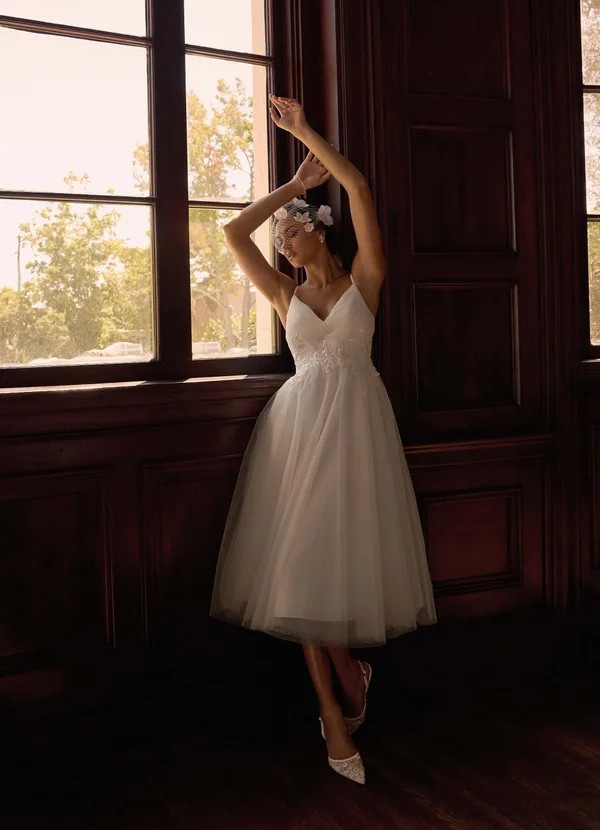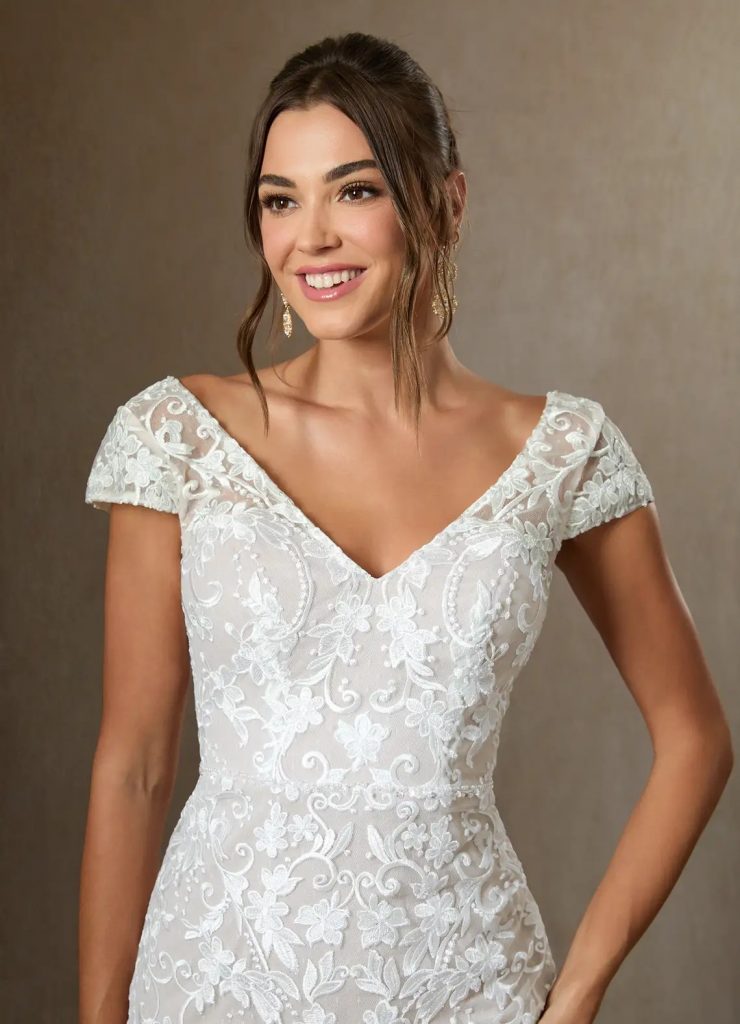What to Expect During a Wedding Dress Fitting
Finding the dress is a magical moment — but the fitting process is what truly makes it yours.
Every bride’s body is unique, and your gown should fit like a glove from neckline to hem.
Below, we’ll walk you through everything you can expect during your wedding dress fittings — from preparation tips and fitting timelines to alteration steps, what to bring, and FAQs.
Overview: Why Dress Fittings Matter
- A perfectly fitted gown enhances your comfort, confidence, and movement on your big day.
- Most brides require 2–3 fittings, scheduled several weeks apart.
- Alterations are common even for custom-size orders, ensuring the gown drapes beautifully.
- A skilled seamstress will refine every detail — from bust adjustments to train bustle points.
Typical Wedding Dress Fitting Timeline
| Stage | When It Happens | Key Adjustments | Notes |
| First Fitting | 8–10 weeks before the wedding | Overall size check, pinning, basic adjustments | Bring shoes and undergarments |
| Second Fitting | 4–6 weeks before | Hemline, straps, bodice shaping | Practice walking and sitting |
| Final Fitting | 1–2 weeks before | Fine-tuning, bustle attachment, pressing | Confirm comfort and mobility |
| Pickup | 1 week before | Steam and final inspection | Store safely until the big day |
What Happens at Each Fitting

The First Fitting: Foundation and Fit Check
This is the most exciting step — the first time you’ll see your actual gown on your body.
Expect:
- A complete try-on with your wedding shoes and undergarments.
- Your seamstress will mark or pin areas for adjustment:
- Bust, waist, and hips.
- Straps and sleeves.
- Length (with heels on).
- Discuss any design changes (neckline, sleeves, train, etc.).
- Confirm comfort — can you sit, dance, and lift your arms easily?
Bring:
- Wedding shoes (correct heel height).
- Undergarments or shapewear you’ll wear on the wedding day.
- Hair accessories or veil if needed for proportion checks.
The Second Fitting: Adjustments & Refinement
At this stage, your dress starts to look and feel like it was made for you.
Expect:
- Adjustments from the first fitting will be complete.
- Check that the gown hugs your curves comfortably.
- Confirm hemline — it should barely touch the floor when standing straight.
- Test mobility: walk, sit, and lift arms.
- Try on accessories (veil, jewelry, or wrap).
Checklist:
- Confirm comfort and neckline placement.
- Check zipper or button closure for ease.
- Review bustle for ease of use (train lifting system).
The Final Fitting: Perfecting the Look

This is your last check before you take your dress home.
Expect:
- The gown should fit flawlessly — no slipping straps or tight seams.
- Your seamstress may steam or press the dress for photos.
- Practice walking, turning, and sitting again.
- Learn how to bustle the dress for the reception.
Pro tip: Bring your maid of honor or a trusted friend. They can watch how to tie or fasten your bustle properly.
Common Wedding Dress Alterations
| Alteration Type | What It Fixes | Notes |
| Hemline Adjustment | Length too long or short | Done while wearing wedding shoes |
| Bustle Addition | Lifts train after ceremony | Several styles (French, American) |
| Bust Adjustment | Too loose or tight at top | Often requires minor hand-stitching |
| Waist & Hip Tapering | Contours silhouette | Usually done during 1st–2nd fitting |
| Straps & Sleeves | Tightening or shortening | Ensures mobility |
| Neckline Changes | Style updates or comfort | Requires seamstress approval |
| Lining or Bra Cups | Added support | Customizable per preference |
Tips to Prepare for Your Wedding Dress Fitting
- Schedule early: Begin fittings 8–10 weeks before your wedding.
- Bring your full look: Shoes, shapewear, jewelry, veil, hairpiece — all affect fit.
- Avoid last-minute weight changes: Large fluctuations can impact alterations.
- Plan your hair and makeup: It helps visualize your complete bridal look.
- Don’t stress over pins or chalk: These are part of perfecting your silhouette.
- Walk naturally: Tell your seamstress if anything feels too tight or loose.
Quick Fitting Prep Checklist
| Item | Bring It? | Why It Matters |
| Wedding shoes | ✅ | Determines hem length |
| Shapewear | ✅ | Affects fit and drape |
| Veil / accessories | ✅ | Check proportions |
| Undergarments | ✅ | Essential for bust fit |
| Trusted friend | Optional | Helps with bustle practice |
| Hair tied or styled | Recommended | Visualize full bridal look |
What Brides Often Forget
- Bustle training: Learn how your bustle works before the big day.
- Standing vs. sitting test: Your gown should look elegant in both poses.
- Lighting check: Look at the dress under natural and indoor light.
- Photography readiness: Ask for a few photos during final fitting to test angles.
- Backup safety: Keep a small sewing kit or safety pins for emergencies.
Expert Advice from Bridal Stylists

- “Always mention your wedding venue — outdoor vs indoor affects fabric and hem.”
- “If your gown has lace or beadwork, allow extra time for hand alterations.”
- “Don’t worry about minor wrinkles; they’ll be steamed before pickup.”
- “Bring emotional support — it’s a big milestone moment!”
After Your Final Fitting
Dress Pickup and Storage Tips:
- Pick up your gown about 1 week before your wedding.
- Keep it in a breathable garment bag.
- Store it upright or lay flat, away from direct sunlight.
- Transport it carefully — avoid sharp folds or creases.
- On the wedding day, use a handheld steamer for touch-ups.
After the Wedding:
- Have the gown professionally cleaned within a week.
- Store it flat in acid-free tissue and a preservation box.
- Avoid plastic bags (they trap moisture).
Quick Reference
| Stage | Timeframe | Key Focus | Bring Items |
| First Fitting | 8–10 weeks before | Overall fit, pinning | Shoes, shapewear |
| Second Fitting | 4–6 weeks before | Hemline, shaping | Veil, accessories |
| Final Fitting | 1–2 weeks before | Comfort, bustle | Friend, camera |
| Pickup | 1 week before | Steam, storage | Garment bag |
Final Takeaway
Your wedding dress fitting is not just about tailoring — it’s a special moment that transforms your gown into a perfect reflection of you.Come prepared, stay patient, and communicate openly with your seamstress.
By your final fitting, every pin, stitch, and bustle loop will come together to create a dress that moves with you and captures your unique beauty on your big day.
Frequently Asked Questions
How long does a wedding dress fitting take?
Usually 45–90 minutes per session. Complex gowns or detailed alterations may take longer.
How many fittings do most brides need?
Most need 2–3 fittings. Custom designs or major adjustments may need a fourth.
What should I wear to my fitting?
Wear the same shoes and undergarments you plan to wear at your wedding for accurate measurements.
Can I make design changes during fittings?
Minor ones like strap adjustments or adding sleeves — yes. Major redesigns may require extra time.
What if I lose or gain weight after my final fitting?
Contact your seamstress immediately; small changes can be corrected quickly if caught early.
How do I keep my gown wrinkle-free until the wedding?
Hang it in a cool, dry place and cover it with a breathable garment bag. Steam lightly on the day of your wedding.
